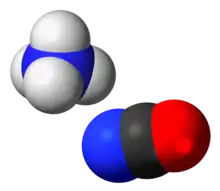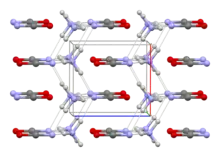Ammonium cyanate
Ammonium cyanate is an inorganic compound with the formula [NH4]+[OCN]−. It is a colorless, solid salt.
 | |
 | |
 | |
| Identifiers | |
|---|---|
3D model (JSmol) |
|
| ChemSpider | |
PubChem CID |
|
CompTox Dashboard (EPA) |
|
| |
| |
| Properties | |
| [NH4][OCN] | |
| Molar mass | 60.056 g·mol−1 |
| Appearance | Colorless crystals |
Except where otherwise noted, data are given for materials in their standard state (at 25 °C [77 °F], 100 kPa).
Infobox references | |
Structure and reactions

Conversion of ammonium cyanate into urea
The structure of this salt was verified by X-ray crystallography. The respective C–O and C–N distances are 1.174(8) and 1.192(7) Å, consistent with the O=C=N− description. Ammonium cation [NH4]+ forms hydrogen bonds with cyanate anion O=C=N−, but to N, not to O.[1]
The compound is notable as the precursor in the Wöhler synthesis of urea, an organic compound, from inorganic reactants.[2] This led to the discarding of the Vital force theory, suggested earlier by Berzelius.
- NH+4 + OCN− → (NH2)2CO[3]
References
- MacLean, Elizabeth J.; Harris, Kenneth D. M.; Kariuki, Benson M.; Kitchin, Simon J.; Tykwinski, Rik R.; Swainson, Ian P.; Dunitz; Jack D. (2003). "Ammonium cyanate shows N-H···N hydrogen bonding, not N-H···O". Journal of the American Chemical Society. 125: 14449–14451. doi:10.1021/ja021156x.
- Friedrich Wöhler (1828). "Ueber künstliche Bildung des Harnstoffs". Annalen der Physik und Chemie. 88 (2): 253–256. Bibcode:1828AnP....88..253W. doi:10.1002/andp.18280880206.
- Shorter, J. (1978). "The conversion of ammonium cyanate into urea. A saga on Reaction mechanisms". Chemical Society Reviews. 7: 1–14. doi:10.1039/CS9780700001.
This article is issued from Wikipedia. The text is licensed under Creative Commons - Attribution - Sharealike. Additional terms may apply for the media files.